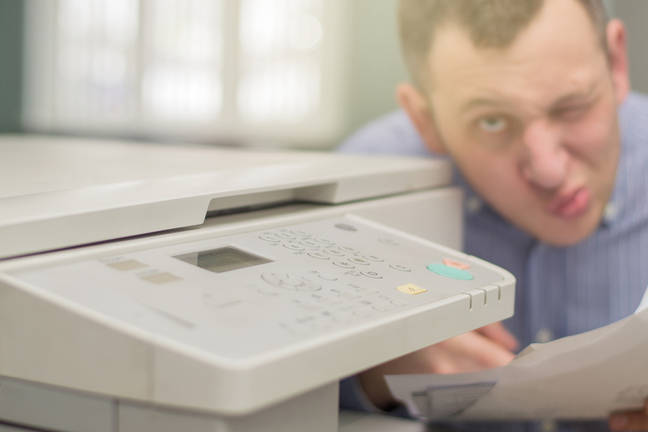Hold Up World, HP's All-in-one Print Subscription's About To Land, And Don't Forget AI PCs

HP Ink recorded its seventh quarter of shrinking revenues as enterprise customers voted to sweat their assets for longer amid economic uncertainty, but with a new all-in-one print sub coming and AI PCs it is feeling bolder.
The world’s number one print vendor and second largest PC maker said revenues for its Q1 ended 31 January, were down 4.4 percent year-on-year to $13.2 billion, and CEO Enrique Lores described the sales landscape as “volatile,” and one that continues to impact demand across our industry.”
Analysts had estimated a topline of $13.56 billion, and so HP's shares dipped three percent in after hours trading.
The Personal Systems division was down four percent to $8.8 billion, with Consumer down one percent and Commercial down five percent. Printing was down five percent to $4.4 billion, with Consumer down 22 percent and and Commercial down 12 percent. Supplies revenue was flat.
"The external environment remains dynamic," said Lores on a conference call. "In Consumer, we anticipate that a post-holiday slowdown, and this was a bit more pronounced than initially expected. Commercial customers remain cautious. While we saw signs of stabilization in the SMB and education markets, we saw a slowdown in US enterprise and federal sales, especially in the month of January."
Taking the positives where he could find them, the CEO pointed out the rate of revenue was declining, which points to “market stabilization.”
He added: “We're maintaining our investments in a down market to strengthen our competitive position and there are several bright spots this quarter.” Gaming PCs and “continued momentum” in Instant Ink subscriptions were among them.
According to analysts at IDC, the PC market “bottomed out” in calendar Q4 following “unprecedented consecutive declines” since it started tracking shipments in 1995 - eight quarters of year-on-year falls.
Concentrating on things he can control – unlike market demand – Lores said HP is “managing our mix, reducing our costs and maximizing operational efficiencies.” He said the corp is on track to deliver annual run rate structural cost savings of $1.6 billion by the end of this year.
HP reduced its overheads to $12.25 billion in Q1 versus $13.055 billion a year earlier, helping to lift net profit by 33 percent to $600 million.
Like its peers, HP is hoping for better trading conditions as the year progresses, laboring under the expectation that a Windows 11 refresh and on-device AI will breath new life into a flagging PC sector, one that swelled during the pandemic but has since collapsed amid market saturation and malaise in the economy.
“Alongside the PC opportunity, we continue to develop new AI applications to run on top of our installed base of more than 200 million commercial devices. The best example of this is the workforce central platform,” said Lores. This was renamed to the HP Workforce Experience platform.
“It integrates data and telemetry from our PC printer and poly devices into a single dashboard to improve productivity, security and collaboration, and it is now available to all of our managed solution customers.”
Around 100 AI PCs were announced at MWC this week from all the usual players. HP, including HP, Dell and many others.
- HP's CEO spells it out: You're a 'bad investment' if you don't buy HP supplies
- IDC: AI is a solution for a PC industry with a sales problem
- Should leaders place bets on new PCs or generative AI?
- AI PC hype bubble swells, but software support lags marketing
- Windows 12: Savior of PC makers, or just an apology for Windows 11?
- HP exec says quiet part out loud when it comes to locking in print customers
Another fresh initiative is the incoming launch this week of the HP all-in subscription plan. “For a monthly fee, consumers will receive a printer in delivery, premium 24/7 support and an option to upgrade their hardware every two years. This has tested extremely well in our pilots with customer satisfaction exceeding Instant Ink's already high scores.”
HP has moved in recent years to protect its margin-rich printer supplies revenues from pesky third party cartridge manufacturers – a move that has attracted the interest of lawyers.
“Despite pockets of softness in Q1, we saw signs of improvement overall,” said Lores in summary. He added that HP expects the “pace of recovery to be uneven across different segments.”
HP’s results follow those of Lenovo last week, which reported growth in PC revenue after five consecutive quarters of revenue decline, and Dell is due to report its financial results later today. ®
From Chip War To Cloud War: The Next Frontier In Global Tech Competition
The global chip war, characterized by intense competition among nations and corporations for supremacy in semiconductor ... Read more
The High Stakes Of Tech Regulation: Security Risks And Market Dynamics
The influence of tech giants in the global economy continues to grow, raising crucial questions about how to balance sec... Read more
The Tyranny Of Instagram Interiors: Why It's Time To Break Free From Algorithm-Driven Aesthetics
Instagram has become a dominant force in shaping interior design trends, offering a seemingly endless stream of inspirat... Read more
The Data Crunch In AI: Strategies For Sustainability
Exploring solutions to the imminent exhaustion of internet data for AI training.As the artificial intelligence (AI) indu... Read more
Google Abandons Four-Year Effort To Remove Cookies From Chrome Browser
After four years of dedicated effort, Google has decided to abandon its plan to remove third-party cookies from its Chro... Read more
LinkedIn Embraces AI And Gamification To Drive User Engagement And Revenue
In an effort to tackle slowing revenue growth and enhance user engagement, LinkedIn is turning to artificial intelligenc... Read more

